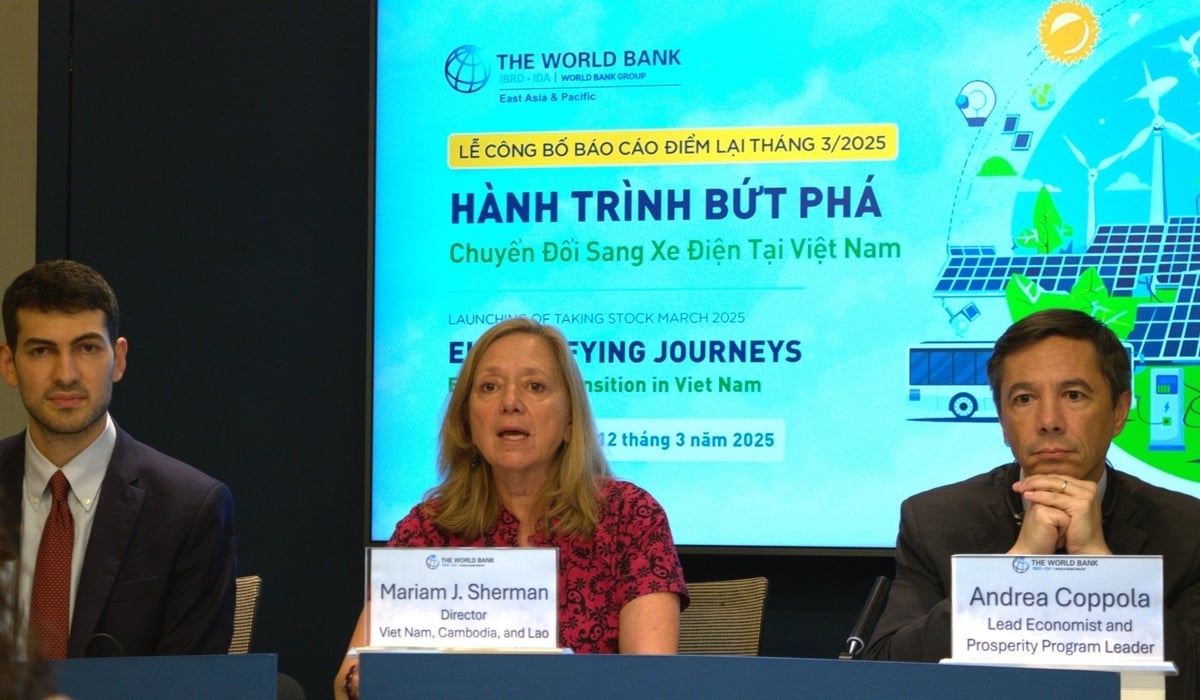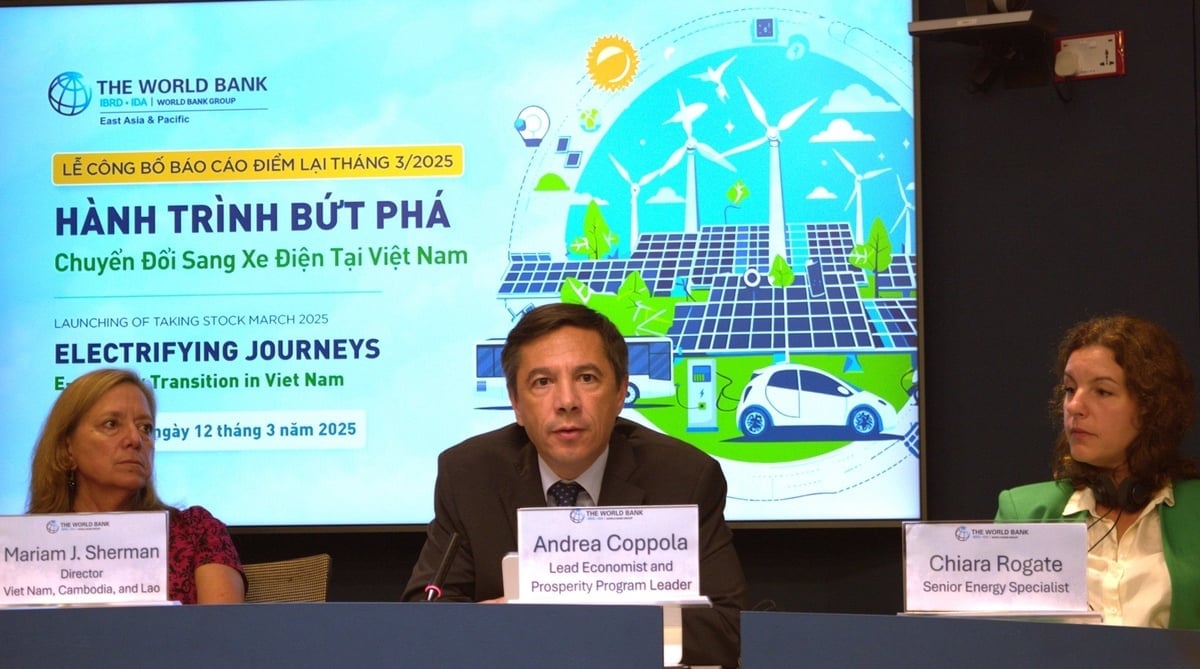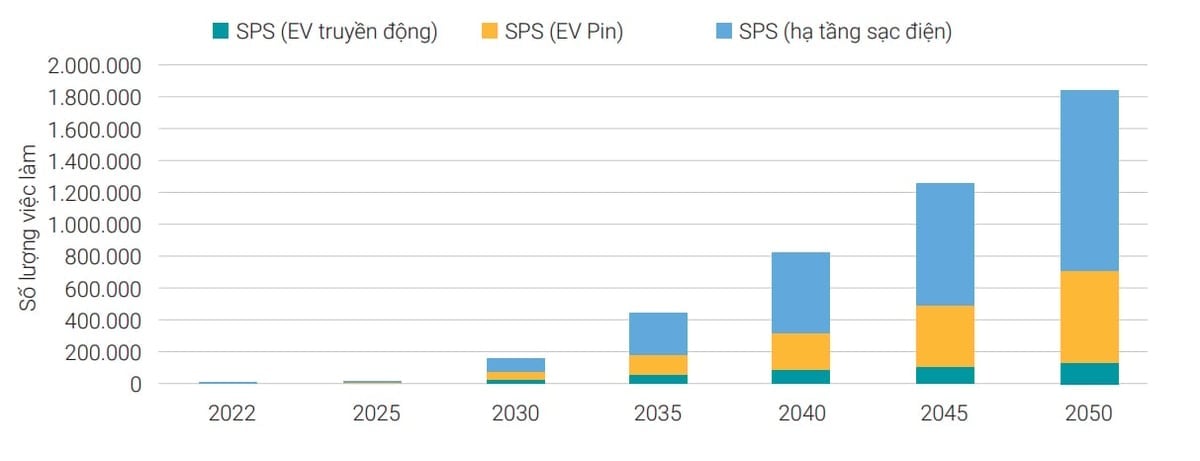November 28, 2025 | 06:05 GMT +7
November 28, 2025 | 06:05 GMT +7
Hotline: 0913.378.918
November 28, 2025 | 06:05 GMT +7
Hotline: 0913.378.918
On March 12, the World Bank (WB) released the "Taking Stock" report - Vietnam's latest economic update report. Along with detailed information on the country's economic outlook and growth strategy, this year, the WB emphasized promoting the transition to electric vehicles and proposed a breakthrough roadmap towards the goal of net zero emissions in Vietnam.
Speaking at the report launch, Mariam J. Sherman, World Bank Country Director for Viet Nam, Cambodia, and Lao PDR, said: WB forecasts that Vietnam will maintain strong economic growth over the next two years - at 6.8% in 2025 and 6.5% in 2026 - but needs to use its fiscal space better to prepare for rising uncertainties.
Given the high openness of Vietnam's economy, key uncertainties include lower-than-expected global growth, especially in major trading partners such as the United States, the European Union, and China. In addition, unclear trade policies and deepening trade divisions among countries and regions could affect Vietnam's manufacturing exports, industrial output, and growth.

Mariam J. Sherman, World Bank Country Director for Viet Nam, Cambodia, and Lao PDR, speaks at the report launch ceremony. Photo: Trung Nguyen.
Commenting on the 8% growth target by 2025 set by the Vietnamese Government, Andrea Coppola, Lead Economist and Program Leader for Viet Nam, Cambodia and Lao PDR, said that it is achievable but requires a favorable international context, with strong momentum from major trade partners such as Europe and the United States.
The World Bank forecasts that in 2025, Vietnam will continue to grow rapidly and be one of the countries with high growth rates in Southeast Asia. The growth rate of 6.8% is based on the latest economic data in the first months of this year. For example, Vietnam's goods exports in the first two months of this year increased by about 8% compared to the same period last year, while in the first two months of 2024, the increase was 20% compared to 2023. This year's foreign direct investment (FDI) will only reach USD 2.2 billion, far lower than the USD 3.6 billion in the same period last year...
Due to the forecast of a short-term slowdown in economic growth in Vietnam's largest trading partners, China and the United States, exports, which have recovered well in 2024, are expected to slow down this year and continue to decline in 2026. The growth momentum will come from domestic economic and service activities, and in 2026, the real estate market will gradually recover thanks to faster project approvals. On the other hand, increased public investment will continue contributing to the total demand for goods and services and growth. Regarding domestic consumption, purchasing power has not yet reached expectations as consumers tighten spending in the context of cautious employment and income prospects.

Andrea Coppola, Lead Economist and Program Leader for Viet Nam, Cambodia and Lao PDR, shares about the driving forces behind Vietnam's economic growth. Photo: Trung Nguyen.
The World Bank representative said that although the economy will grow steadily in 2025-2026, the current infrastructure shortage requires more investment if growth momentum is to be maintained in the following years. Vietnam's public debt level is still low compared to many countries in the region, and improvements in public investment management can help the state allocate necessary resources for investment, especially in energy, logistics, and transport.
In particular, it is essential to focus on increasing the supply of low-emission energy for economic growth in Vietnam's need to meet energy transition goals. If well applied, the indicators in the National Program on Energy Efficiency and Conservation for the 2019-2030 period (VNEEP 3) will improve productivity in sectors and reduce energy use, especially for industrial production.
This year, the World Bank has dedicated a special section to analyzing the transition to electric vehicles in Vietnam in its latest economic update, with an essential role in achieving the goal of net zero emissions by 2050.
The transport sector accounts for about 7.2% of the total greenhouse gas emissions of the Vietnamese economy, most of which are due to road transport. Although car ownership is still a luxury for most Vietnamese people today, the growth of the middle class has been increasing car sales with an average compound growth rate of up to 15% from 2010 to 2022, among the highest in the region.

Jobs were created in the transition to electric vehicles under the World Bank's high decarbonization scenario. Photo: WB.
Vietnam is well-positioned to benefit from the start of the transition to car-based mobility and the leap from traditional cars to electric vehicles. Chiara Rogate, Senior Energy Specialist at the World Bank, said that in Vietnam, two-wheeled vehicles will remain the primary means of transport until 2035. Therefore, the transition must start with this segment. The transition to electric vehicles also presents great opportunities for economic development. The market demand for electric vehicles of all types is forecast to reach over 7 million units in 2024-2030 and 71 million units in 2031-2050.
In the immediate future, to accelerate the adoption of electric vehicles in the two-wheeled vehicle segment, the World Bank recommends that Vietnam implement safety standards, encourage high-performance batteries, and expand charging stations and battery swapping. At the same time, it introduces financial options and preferential prices to offset upfront costs. Electric vehicle sales in Vietnam are forecasted to explode from around 2035. Therefore, within the next 10 years, the power system infrastructure needs to be prepared to meet the increasing electricity demand and establish a fast charging network across the country.
Translated by Huong Giang

(VAN) On November 27, in the meeting with Minister Tran Duc Thang, Mayor Yin Yong shared Beijing’s experience to improve environment and air quality.

(VAN) After 30 years, both sides identified strategic areas of cooperation: sustainable production, increasing coffee value and training for farmers.
/2025/11/27/4910-4-164708_294.jpg)
(VAN) On the afternoon of November 27 in Beijing, Minister of Agriculture and Environment Tran Duc Thang held a working session with several major Chinese enterprises operating in the agriculture and environment sector.

(VAN) The Department of Animal Health issued a provisional guideline requesting local authorities to increase surveillance, collect samples for testing, and conduct epidemiological investigations according to the established procedure.

(VAN) The United Nations recommends that Vietnam utilize data and artificial intelligence to enhance early disaster warnings and reduce GDP losses by 3.2% in the context of climate change.

(VAN) On the morning of November 27 in Beijing, Minister Tran Duc Thang and the Deputy Commissioner General of the General Administration of Customs of China signed a protocol on fresh jackfruit exports.

(VAN) As floodwaters recede, a vast network of irrigation works across eastern Gia Lai is emerging in a state of severe disrepair, with extensive damage demanding urgent restoration ahead of the 2025-2026 winter-spring cropping season.